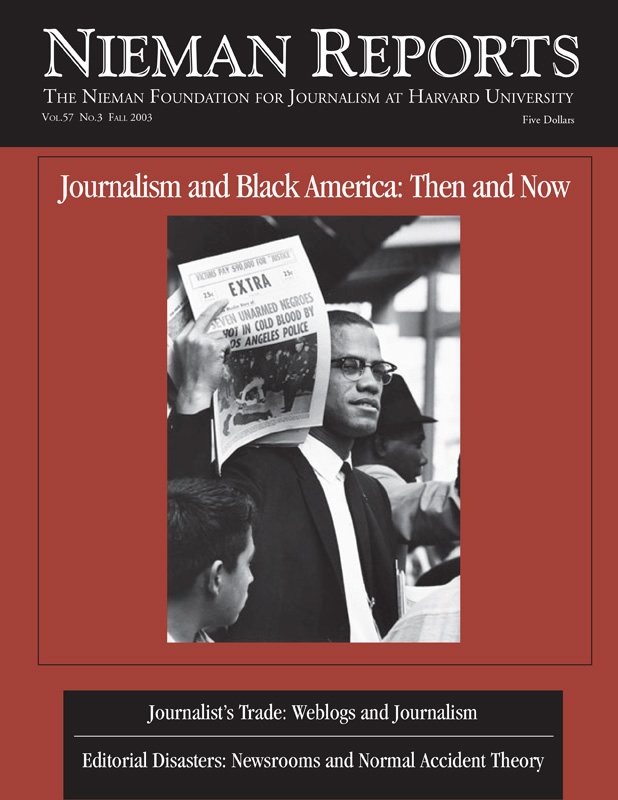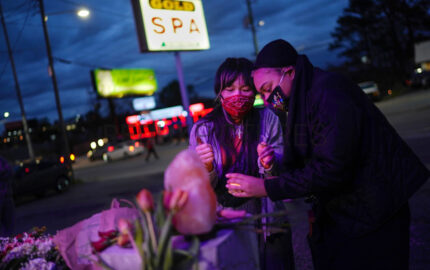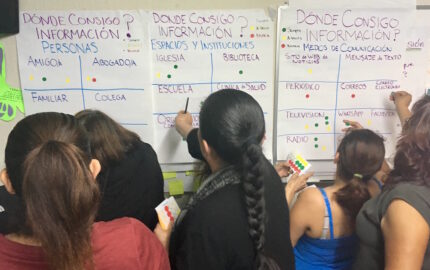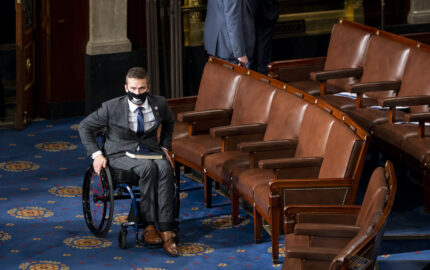The meteoric rise of former New York Times reporter Jayson Blair and his swift and sudden fall into disgrace has given us in the National Association of Black Journalists (NABJ) much about which to think, write and talk. The “Blair Incident,” as we have called it, also signals an NABJ call to action. Our organization has stated clearly and repeatedly that there is no excuse and perhaps no satisfactory explanation for Blair’s abhorrent behavior. He was wrong and is being held accountable for his actions. The notion that Blair will likely profit from his dishonesty should repulse all of us.
Those who ultimately managed Blair have also been held accountable for their actions. Howell Raines and Gerald Boyd resigned their positions as executive editor and managing editor at the Times. However, it appears that the managers with more daily contact with this reporter could have done more to prevent the tsunami of destruction done to the newspaper’s credibility and to the morale of its employees. Blair needed coaches. Instead, he had cheerleaders who failed to hold him accountable for the responsibility he assumed when he joined this prestigious news organization.
The New York Times will emerge stronger from this dark period in its 152-year history, as will our industry. For better or for worse, Blair’s actions shone a white-hot light on the value of newsroom diversity initiatives. NABJ, like The New York Times and many other media companies, recognizes the value in having the diversity that is America reported on by those with different voices and experiences. The content of our news coverage should reflect what is happening throughout the community.
Why Diversity Matters
Our challenge now lies in illustrating the benefits of diversity to the readers, listeners and viewers as well as to those opposed to “a hand up and not a hand out.” We accomplish this goal by how we compose our newsroom staff and the quality of our coverage that emerges from it. While few openly state opposition to newsroom diversity initiatives, clearly the industry is a long way from aligning its staffing with the demands for coverage of increasingly diverse communities.
Why is this disconnect still with us? I believe we are still not comfortable having conversations about race. Managers fear being labeled “racist” while journalists of color fear being labeled “not qualified enough.” These are issues we discuss among ourselves, but most of us haven’t found a safe place or way to discuss racial issues with one another. Another challenge our industry faces in trying to reach its goals involves expectations and lifestyles. Many entry-level journalists of color come from the nation’s big cities and urban communities, and many of them want and expect to work in communities familiar to them. But the industry, especially newspapers, need entry-level journalists of color in our smaller cities and communities, places that might lack the cultural environments to which these entry-level journalists of color are accustomed.
This imbalance of expectation and need is something NABJ can help to address. As an organization, we already work to strengthen ties among African-American journalists and promote diversity in newsrooms. We honor excellence and outstanding achievement in the media industry and work to expand job opportunities and recruiting activities for established African-American journalists and students interested in journalism. And NABJ looks for ways to expand and balance the media’s coverage of the African-American community and experience.
Everyone—from NABJ and other organizations for journalists of color to the hiring managers in the industry—must urge entry-level journalists among its members to entertain and to accept employment offers in the country’s smaller and medium markets where their skills are needed. There will be benefits for them, as well. Rookie journalists can learn, in a less-pressured environment, from the inevitable mistakes they will make and hone their skills across a range of assignments. There is something worth emulating in the way in which Major League Baseball relies on its system of farm teams. What better way is there to get the best prospects in the pipeline and ready them for the big time? There is also something to be said for understanding the value of “paying dues” and “earning stripes,” an understanding that some younger journalists don’t seem to have.
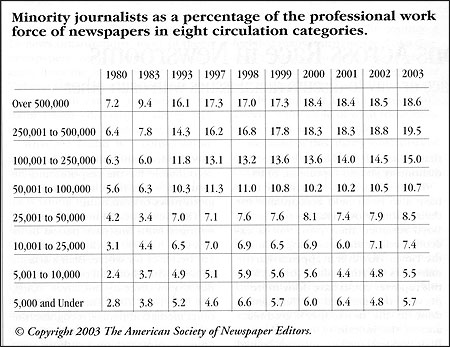
Discussing Race Among Journalists
NABJ can communicate this message to student members and entry-level journalists. However, it will be most effectively preached one journalist at a time by individual members who can share what they have learned from their experiences. Groups like NABJ can make other contributions as well. By using our Media Institute for journalism education as the vehicle and relying on NABJ member journalists in senior management positions as facilitators, NABJ can create the safe place so desperately needed by journalists to have necessary, difficult and rare conversations about race in the news-room—and have them across race. Such discussions would benefit all of us and improve what we, as journalists, produce.
RELATED ARTICLE
"Newsroom Diversity: Truth vs. Fiction"
- Bryan MonroeBut there is work for the journalism industry to do as well. It must continue to support minority journalism organizations like NABJ by recruiting not only at our annual conventions but also year-round via programming like the NABJ Media Institute and the National Association of Hispanic Journalists’ Parity Project. While it might continue to be fashionable and cost effective to do more with less, when the economy finally rebounds the business side of journalism (with its ongoing emphasis on bottom line profit) must provide journalists with the necessary resources to achieve the goals of a diverse newsroom.
Every young journalist—not only those of color—needs supportive mentoring and solid training when they start working in the newsroom. Editors (and other journalists) also need support for and solid training in ways to manage diverse newsrooms successfully. There is no reason for black journalists, especially young ones, to be forced to wear the scarlet letter for the sins of one bad journalist who is black. Thousands of black journalists go to work each day committed to upholding the standards of an industry that the civil rights movement led us to integrate and in which we continue a struggle to advance.
In the Jayson Blair incident there was sufficient blame to share. To attribute race as the cause of Blair’s actions is unfair and wrong. In fact, in his memo to the staff of The New York Times, the newspaper’s new executive editor, Bill Keller, observed that in a detailed report on the Blair incident journalists from outside the paper “answered the charge by some of our more partisan critics that the Blair case was a consequence of our determination to hire and promote a diverse staff.”
“That charge, they make clear, is wrong,” Keller wrote.
For us, as we move forward, the lesson is about taking risk. For entry-level journalists of color the risk comes in taking a job in a community where again you might be the first or the only one who looks like you in the newsroom and sacrificing social comfort in the short term, knowing a greater reward comes later. For the newsroom managers who work with journalists of color, one risk is to figure out ways to get over the hurdle of having a young staffer confuse constructive criticism with racism. Only when we find ways to discuss these unnerving and discomforting issues will we advance our craft and our service to it.
I am willing to take that step. Are you?
Condace Pressley is the 14th president of the National Association of Black Journalists. Her term as president ended in August 2003. Pressley is the assistant program director of the nation’s top rated news talk radio station, News/Talk 750 WSB in Atlanta, Georgia.
Those who ultimately managed Blair have also been held accountable for their actions. Howell Raines and Gerald Boyd resigned their positions as executive editor and managing editor at the Times. However, it appears that the managers with more daily contact with this reporter could have done more to prevent the tsunami of destruction done to the newspaper’s credibility and to the morale of its employees. Blair needed coaches. Instead, he had cheerleaders who failed to hold him accountable for the responsibility he assumed when he joined this prestigious news organization.
The New York Times will emerge stronger from this dark period in its 152-year history, as will our industry. For better or for worse, Blair’s actions shone a white-hot light on the value of newsroom diversity initiatives. NABJ, like The New York Times and many other media companies, recognizes the value in having the diversity that is America reported on by those with different voices and experiences. The content of our news coverage should reflect what is happening throughout the community.
Why Diversity Matters
Our challenge now lies in illustrating the benefits of diversity to the readers, listeners and viewers as well as to those opposed to “a hand up and not a hand out.” We accomplish this goal by how we compose our newsroom staff and the quality of our coverage that emerges from it. While few openly state opposition to newsroom diversity initiatives, clearly the industry is a long way from aligning its staffing with the demands for coverage of increasingly diverse communities.
Why is this disconnect still with us? I believe we are still not comfortable having conversations about race. Managers fear being labeled “racist” while journalists of color fear being labeled “not qualified enough.” These are issues we discuss among ourselves, but most of us haven’t found a safe place or way to discuss racial issues with one another. Another challenge our industry faces in trying to reach its goals involves expectations and lifestyles. Many entry-level journalists of color come from the nation’s big cities and urban communities, and many of them want and expect to work in communities familiar to them. But the industry, especially newspapers, need entry-level journalists of color in our smaller cities and communities, places that might lack the cultural environments to which these entry-level journalists of color are accustomed.
This imbalance of expectation and need is something NABJ can help to address. As an organization, we already work to strengthen ties among African-American journalists and promote diversity in newsrooms. We honor excellence and outstanding achievement in the media industry and work to expand job opportunities and recruiting activities for established African-American journalists and students interested in journalism. And NABJ looks for ways to expand and balance the media’s coverage of the African-American community and experience.
Everyone—from NABJ and other organizations for journalists of color to the hiring managers in the industry—must urge entry-level journalists among its members to entertain and to accept employment offers in the country’s smaller and medium markets where their skills are needed. There will be benefits for them, as well. Rookie journalists can learn, in a less-pressured environment, from the inevitable mistakes they will make and hone their skills across a range of assignments. There is something worth emulating in the way in which Major League Baseball relies on its system of farm teams. What better way is there to get the best prospects in the pipeline and ready them for the big time? There is also something to be said for understanding the value of “paying dues” and “earning stripes,” an understanding that some younger journalists don’t seem to have.

Discussing Race Among Journalists
NABJ can communicate this message to student members and entry-level journalists. However, it will be most effectively preached one journalist at a time by individual members who can share what they have learned from their experiences. Groups like NABJ can make other contributions as well. By using our Media Institute for journalism education as the vehicle and relying on NABJ member journalists in senior management positions as facilitators, NABJ can create the safe place so desperately needed by journalists to have necessary, difficult and rare conversations about race in the news-room—and have them across race. Such discussions would benefit all of us and improve what we, as journalists, produce.
RELATED ARTICLE
"Newsroom Diversity: Truth vs. Fiction"
- Bryan MonroeBut there is work for the journalism industry to do as well. It must continue to support minority journalism organizations like NABJ by recruiting not only at our annual conventions but also year-round via programming like the NABJ Media Institute and the National Association of Hispanic Journalists’ Parity Project. While it might continue to be fashionable and cost effective to do more with less, when the economy finally rebounds the business side of journalism (with its ongoing emphasis on bottom line profit) must provide journalists with the necessary resources to achieve the goals of a diverse newsroom.
Every young journalist—not only those of color—needs supportive mentoring and solid training when they start working in the newsroom. Editors (and other journalists) also need support for and solid training in ways to manage diverse newsrooms successfully. There is no reason for black journalists, especially young ones, to be forced to wear the scarlet letter for the sins of one bad journalist who is black. Thousands of black journalists go to work each day committed to upholding the standards of an industry that the civil rights movement led us to integrate and in which we continue a struggle to advance.
In the Jayson Blair incident there was sufficient blame to share. To attribute race as the cause of Blair’s actions is unfair and wrong. In fact, in his memo to the staff of The New York Times, the newspaper’s new executive editor, Bill Keller, observed that in a detailed report on the Blair incident journalists from outside the paper “answered the charge by some of our more partisan critics that the Blair case was a consequence of our determination to hire and promote a diverse staff.”
“That charge, they make clear, is wrong,” Keller wrote.
For us, as we move forward, the lesson is about taking risk. For entry-level journalists of color the risk comes in taking a job in a community where again you might be the first or the only one who looks like you in the newsroom and sacrificing social comfort in the short term, knowing a greater reward comes later. For the newsroom managers who work with journalists of color, one risk is to figure out ways to get over the hurdle of having a young staffer confuse constructive criticism with racism. Only when we find ways to discuss these unnerving and discomforting issues will we advance our craft and our service to it.
I am willing to take that step. Are you?
Condace Pressley is the 14th president of the National Association of Black Journalists. Her term as president ended in August 2003. Pressley is the assistant program director of the nation’s top rated news talk radio station, News/Talk 750 WSB in Atlanta, Georgia.
